The 1913 Ford Model T wasn’t just a car; it was a revolution on wheels. Born in a time of horse-drawn carriages and gas-powered curiosities, the Model T emerged as a symbol of innovation, efficiency, and the dawn of mass-produced transportation.
Henry Ford’s vision, coupled with the revolutionary assembly line, brought affordable automobiles to the masses, forever altering the landscape of American society.
The Model T’s impact extended far beyond its sleek design and affordability. It sparked a cultural shift, enabling people to travel farther and faster than ever before, connecting communities and opening up new possibilities for work and leisure. The Model T became a symbol of American ingenuity and progress, solidifying Ford’s legacy as a visionary leader and setting the stage for the automotive industry as we know it today.
The Birth of the Model T
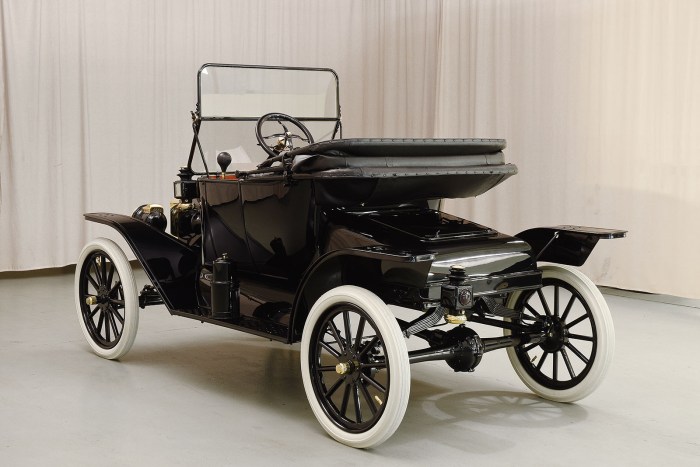
The Ford Model T, introduced in 1908, revolutionized transportation and ushered in the era of mass-produced automobiles. It was a pivotal moment in automotive history, marking a shift from expensive, handcrafted vehicles to affordable, accessible transportation for the average person.
The Model T’s Innovations
The Model T’s success stemmed from several groundbreaking innovations that made it unique and highly desirable:
Assembly Line Production
The Model T was the first automobile to be produced using a moving assembly line, a system pioneered by Henry Ford. This revolutionary production method significantly reduced manufacturing costs and increased production efficiency. The assembly line allowed Ford to build cars faster and cheaper, making them more affordable for the general public.
Standardization and Interchangeability
Ford’s commitment to standardization and interchangeability of parts was another key innovation. Every Model T component was designed to be identical, ensuring that any part could be easily replaced with another, simplifying repairs and reducing downtime. This standardized approach further reduced manufacturing costs and made the Model T more reliable.
Engine Design
The Model T’s engine was simple, robust, and relatively inexpensive to produce. It featured a four-cylinder design with a simple, easily maintained carburetor and a magneto ignition system. This design made the Model T a reliable and durable vehicle that could handle the rough roads of the time.
The Model T Compared to Other Automobiles
The Model T stood out from its contemporaries in several ways:
- Price:The Model T was significantly more affordable than other automobiles of its time. Its price was continually lowered as production ramped up, making it accessible to a wider range of consumers.
- Durability:The Model T was known for its ruggedness and durability, making it suitable for a wide range of uses, including transportation, farming, and commercial applications.
- Simplicity:The Model T was designed for ease of use and maintenance, with a straightforward design and readily available parts.
The Model T’s combination of affordability, reliability, and simplicity made it a phenomenon that transformed the automotive landscape. It not only democratized transportation but also paved the way for the mass production of automobiles, forever changing the world.
Mass Production and Assembly Line
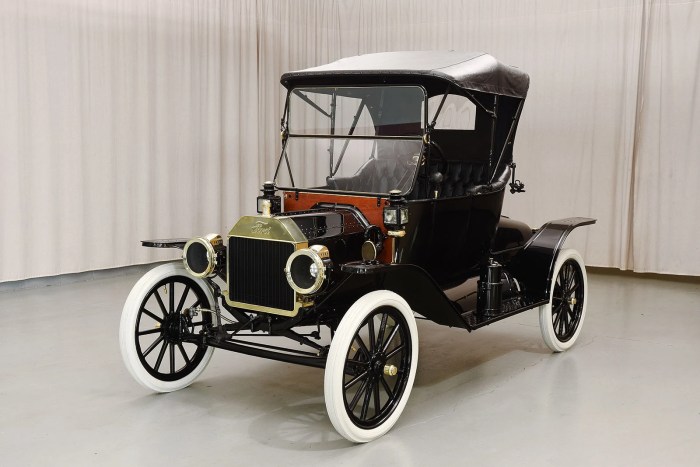
The Ford Model T’s success was not solely due to its innovative design but also to its revolutionary production process. Henry Ford’s implementation of the assembly line transformed manufacturing, making the automobile accessible to a wider market.
The Significance of the Assembly Line, 1913 Ford Model T
The assembly line’s significance in the Model T’s production lies in its ability to dramatically increase efficiency and reduce costs. Before the assembly line, cars were built one at a time, with each worker responsible for assembling the entire vehicle.
This method was slow and expensive, limiting production and making cars a luxury for the wealthy. Ford’s assembly line, however, broke down the car’s construction into smaller, specialized tasks. Workers were assigned to specific stations along the line, performing repetitive tasks on a moving chassis.
This division of labor allowed for greater efficiency and speed, reducing production time and costs.
Impact of the Assembly Line on Manufacturing Efficiency
The assembly line had a profound impact on manufacturing efficiency, leading to several significant changes:* Increased Production:The assembly line allowed Ford to produce cars at a rate never seen before. In 1913, the Model T’s production rate was 240 cars per day, compared to just 10 cars per day using traditional methods.
This increase in production made cars more affordable and accessible to a wider market.
Reduced Costs
By breaking down the manufacturing process into smaller tasks, the assembly line reduced the amount of time and labor required to build a car. This resulted in significant cost savings, which Ford passed on to consumers in the form of lower prices.
The 1913 Ford Model T, with its revolutionary assembly line production, marked a turning point in automotive history. This iconic car paved the way for mass production and affordability, forever changing the landscape of transportation. While the Model T was a symbol of innovation and accessibility, later Ford models like the 1979 Ford Custom showcased a shift towards larger, more luxurious vehicles.
The Model T’s enduring legacy, however, continues to inspire and resonate with car enthusiasts today, reminding us of the transformative power of automotive engineering.
Standardized Production
The assembly line standardized the production process, ensuring that all Model T cars were built to the same specifications. This consistency led to improved quality and reduced the need for repairs.
Comparison of Assembly Line and Traditional Methods
The following table compares the assembly line process to traditional methods of car production:| Feature | Assembly Line | Traditional Method ||—|—|—|| Production Rate | High | Low || Cost per Unit | Low | High || Labor Specialization | High | Low || Standardization | High | Low || Flexibility | Low | High |The assembly line, while highly efficient, lacked flexibility.
It was designed for mass production of a single product, making it difficult to adapt to changes in design or demand. Traditional methods, on the other hand, offered greater flexibility, allowing for the production of a wider range of products and customization.
“The assembly line is a method of production in which a product is assembled in a series of stages, with each worker performing a specific task on the product as it moves along a conveyor belt.”
Model T Design and Features
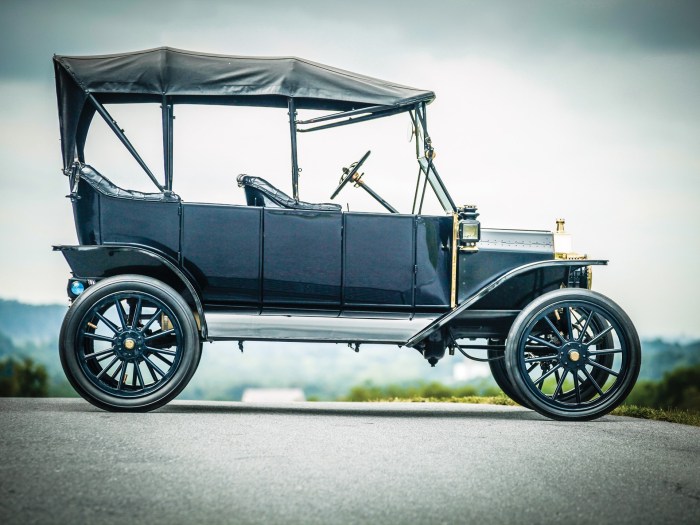
The Ford Model T, a revolutionary automobile that forever changed the landscape of transportation, was not only affordable but also remarkably innovative in its design and features. Its simple yet ingenious engineering, combined with a focus on mass production, made the Model T accessible to a wider audience than ever before.
The Model T’s Design
The Model T’s design was characterized by its simplicity and practicality. It featured a robust, lightweight chassis made of pressed steel, a four-cylinder engine mounted in the front, and a rear-wheel drive system. The car’s suspension was designed for comfort and durability, incorporating leaf springs in the front and a live axle with leaf springs in the rear.
The 1913 Ford Model T, a revolutionary vehicle that democratized transportation, paved the way for the automotive giants of today. While the Model T was a humble, utilitarian vehicle, the automotive landscape has since evolved to encompass behemoths like the 2000 Ford Excursion , a spacious SUV that offers a stark contrast to the Model T’s compact design.
Despite these differences, both vehicles represent the ingenuity and evolution of Ford, a company that has shaped the automotive industry for over a century.
- Engine:The Model T was powered by a 2.9L four-cylinder engine that produced 20 horsepower, sufficient for its time. The engine was a simple and reliable design, with a single carburetor and a magneto ignition system.
- Transmission:The Model T’s transmission was a two-speed planetary gear system, with a reverse gear and a forward gear. The car’s transmission was controlled by a lever mounted on the steering column.
- Steering:The Model T’s steering was a simple and effective design, featuring a worm-and-sector gear system. The steering wheel was located on the right side of the car, as was common at the time.
- Brakes:The Model T’s brakes were mechanically operated, with two drum brakes on the rear wheels. The brakes were controlled by a foot pedal and a hand lever.
Available Options and Customizations
While the Model T was a relatively simple car, it did offer some options and customizations. Customers could choose from a variety of body styles, including the standard touring car, a roadster, a pickup truck, and even a delivery wagon.
The 1913 Ford Model T, with its innovative assembly line production, revolutionized the automotive industry, making cars accessible to the masses. Fast forward to 1961, and Ford was still at the forefront of automotive design, this time with the 1961 Ford Galaxie Sunliner , a stylish convertible that embodied the spirit of the American dream.
While the Model T focused on affordability and practicality, the Galaxie Sunliner showcased the luxury and performance that became synonymous with American cars in the 1960s. Both cars, in their own way, represented significant milestones in Ford’s history and the evolution of the automobile.
- Body Styles:The Model T was offered in a variety of body styles, including the standard touring car, a roadster, a pickup truck, and even a delivery wagon.
- Colors:The Model T was originally available in only black, a decision made by Henry Ford to streamline production and reduce costs. Later, other colors were offered, but black remained the most popular choice.
- Accessories:Ford offered a variety of accessories for the Model T, including a windshield, a top, a rearview mirror, and even a rumble seat.
Impact of the Model T’s Design
The Model T’s design had a profound impact on the development of future automobiles. Its simple and robust design, coupled with its mass production, set a new standard for the automotive industry.
- Mass Production:The Model T’s design was crucial to its success, allowing Ford to implement a revolutionary assembly line production system. This process enabled the production of cars at an unprecedented rate, making them affordable for the average person.
- Standardization:The Model T’s standardized design led to the widespread adoption of interchangeable parts in the automotive industry, further facilitating mass production and reducing costs.
- Technological Advancements:The Model T’s design incorporated several innovative features that would become standard in future automobiles, such as the use of pressed steel for the chassis and the development of a more efficient engine.
The Model T’s Impact on Society
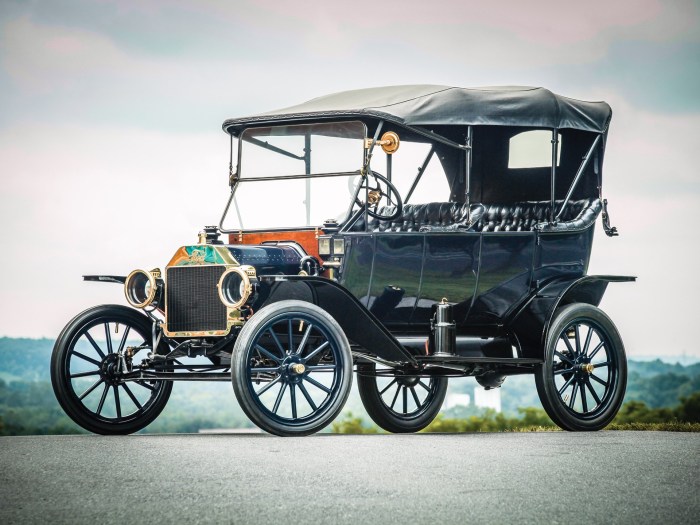
The Ford Model T, more than just a car, was a transformative force that reshaped American society, impacting transportation, the economy, and everyday life. Its affordability, durability, and widespread adoption ushered in a new era of mobility, sparking a cascade of social and cultural changes that continue to resonate today.
Revolutionizing Transportation
The Model T revolutionized transportation, making personal mobility accessible to a broader segment of the population. Prior to its arrival, automobiles were expensive luxuries, largely confined to the wealthy. The Model T, with its affordable price and robust design, democratized car ownership, allowing individuals from all walks of life to experience the freedom and convenience of personal transportation.
The Model T’s impact on transportation extended beyond individual ownership. It spurred the development of a nationwide network of roads and infrastructure, facilitating the movement of goods and people across the country. The rise of the automobile industry also led to the establishment of gas stations, repair shops, and related businesses, creating new industries and employment opportunities.
Growth of the American Economy
The Model T played a pivotal role in the growth of the American economy. Its mass production, utilizing the innovative assembly line system, created a surge in demand for materials, parts, and labor, boosting manufacturing and related sectors. The car’s affordability and widespread adoption stimulated consumer spending, contributing to a period of economic prosperity.The Model T’s influence on the economy was far-reaching.
It facilitated the expansion of suburbs, as people could commute to jobs outside of city centers. It also fostered the growth of tourism and leisure travel, as Americans could now explore their country with greater ease. The car’s impact on the economy was so profound that it is often cited as a key factor in the rise of American industrial dominance in the 20th century.
Social and Cultural Effects
The widespread adoption of the Model T had significant social and cultural effects. It challenged traditional notions of community and family life, as people could now travel farther and more frequently. The car also empowered women, giving them greater independence and mobility.
The Model T’s impact on social life was multifaceted. It fostered a sense of national unity, as Americans could now travel across the country and experience different cultures. It also contributed to the rise of a “car culture,” with roadside attractions, drive-in theaters, and other car-centric businesses becoming commonplace.
The Model T’s influence on society extended to the realm of politics and social reform. The car’s ability to connect people across distances facilitated the spread of ideas and movements, contributing to the rise of social activism and political change.
Legacy of the Model T

The Ford Model T, a revolutionary automobile that transformed transportation and American society, left an indelible mark on the world. Its legacy continues to influence automotive design and manufacturing practices even today. This section will explore the enduring impact of the Model T, examining its milestones, innovations, and enduring influence.
Timeline of Significant Milestones
The Model T’s journey from its inception to its final production represents a pivotal chapter in automotive history. The following timeline highlights key milestones that shaped its impact:
- 1908:The Model T is introduced, marking the beginning of mass production of automobiles.
- 1913:Ford implements the moving assembly line, significantly increasing production efficiency and lowering costs.
- 1914:The Model T becomes the first car to reach a million units produced.
- 1927:After 19 years of production, the Model T is discontinued, having sold over 15 million units.
Comparison with Successors in the Ford Lineup
The Model T paved the way for a succession of iconic Ford vehicles. Here’s a comparison of the Model T with some of its successors:
| Feature | Model T | Model A | Model B | Model C |
|---|---|---|---|---|
| Year Introduced | 1908 | 1927 | 1932 | 1933 |
| Engine | 4-cylinder, 2.9 L | 4-cylinder, 3.3 L | 8-cylinder, 3.6 L | 8-cylinder, 3.6 L |
| Transmission | 2-speed planetary | 3-speed manual | 3-speed manual | 3-speed manual |
| Body Styles | Touring, Roadster, Coupe | Touring, Roadster, Coupe, Sedan | Touring, Roadster, Coupe, Sedan | Touring, Roadster, Coupe, Sedan |
| Production | 15 million | 4 million | 2 million | 1 million |
Enduring Influence on Automotive Design
The Model T’s innovations had a profound and lasting impact on automotive design, shaping the industry for decades to come.
- Mass Production and Assembly Line:The Model T’s assembly line revolutionized manufacturing, making automobiles more affordable and accessible to the masses. This principle continues to be a cornerstone of modern automotive production, with advancements in automation and robotics further enhancing efficiency.
- Standardized Components:The Model T utilized interchangeable parts, simplifying production and repairs. This concept of standardized components remains a fundamental aspect of automotive design, ensuring consistent quality and ease of maintenance.
- Engine Design and Performance:While the Model T’s engine was relatively simple, it paved the way for more sophisticated and powerful engines in subsequent models. Today, advanced engine technologies, including fuel injection, turbocharging, and hybrid systems, are direct descendants of the principles established by the Model T.
- Safety Features:Although rudimentary by today’s standards, the Model T introduced early safety features like headlights and brakes. These features have evolved significantly over time, with modern vehicles incorporating advanced safety technologies such as airbags, anti-lock brakes, and lane departure warnings, all rooted in the foundational principles established by the Model T.
Final Thoughts: 1913 Ford Model T
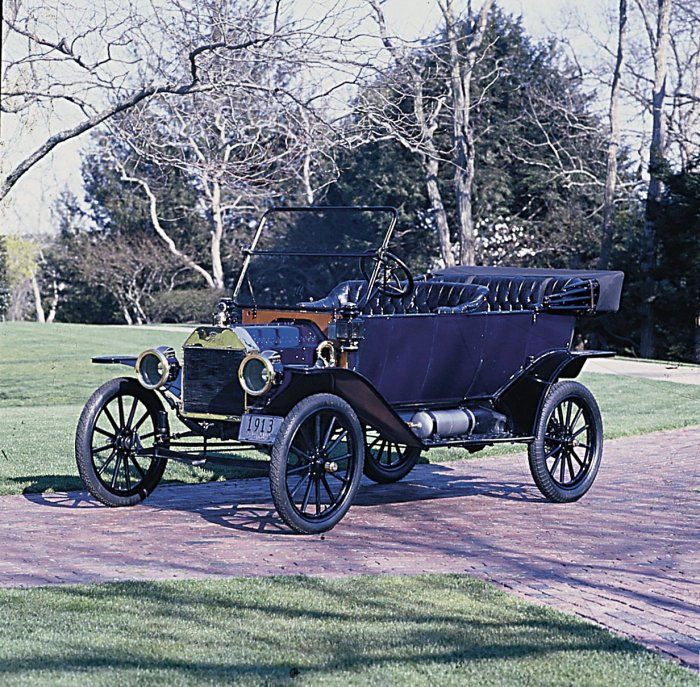
The 1913 Ford Model T stands as a testament to the power of innovation and the impact of a single invention on the course of history. Its legacy continues to resonate in the world of automobiles, inspiring advancements in manufacturing, design, and accessibility.
As we drive down modern highways, we can still feel the echoes of the Model T’s influence, a reminder of the transformative power of an idea that dared to put the world on wheels.